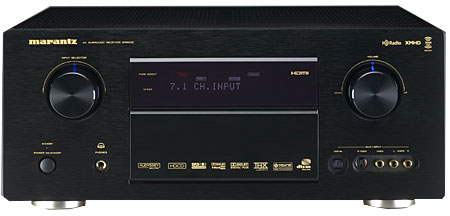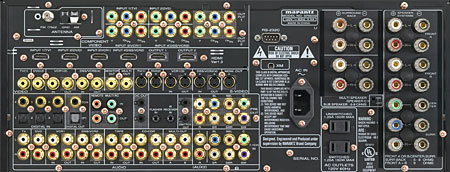Marantz SR8002 A/V Receiver

Features
The top-of-the-line SR8002 is a high-powered THX Select2-certified receiver whose Crystal 192kHz/24-bit DACs and output-stage amplification utilizing discrete components certainly contribute to its superb sound. Build quality is likewise exemplary°I was immediately impressed with the copper-plated chassis intended to block spurious RF radiation from itself or other nearby equipment. The receiver uses premium output capacitors, a monster toroidal transformer, and high-efficiency cast-aluminum heat sinks to develop 125 watts for each of its seven channels. All of this could be viewed as so much marketing bunting, were it not for the fact that the SR8002 really delivers.
In addition to powering your main home theater, the SR8002 provides two additional zones. Room A can receive two-channel audio, either line or speaker level (i.e., amplified) plus composite or component video, while room B is treated strictly to two-channel audio.
THX Select2 certification offers three facets of operation. First is THX Re-EQ, which tames soundtracks that were intentionally "brightened" for their theatrical debut. With the Definitive Technology Mythos speaker system, I set it to engage whenever THX was selected, but left it disengaged with the Martin Logans, which are more naturally rolled off.
Second is Timbre Matching, an integral and non-defeatable feature that tries to electronically compensate for the fleshy outer part of your ear called the pinna, so that your surrounds don't sound jarringly different than your front speakers. Third, THX Adaptive Decorrelation (also non-defeatable when THX is engaged) provides a subtle bit of time and phase manipulation for the rear channels that helps a 5.1 system sound as spacious as what you might hear at your local multiplex.
As with most modern AVRs, the SR8002 provides all the requisite codecs and surround modes. Also available are things like center-channel width for Pro Logic IIx and center gain for DTS Neo:6, which provide quite a bit of control over the whole silk-purse-from-a-sow's-ears aspect of two-channel analog audio sources.
There's even a dynamic-expansion feature called M-Dax, which is meant to breath life into MP3 or other highly compressed sources. It seemed to perform like an old-fashioned "loudness" button, goosing the bass and treble some, but usually with good results. If all the options confuse you, just let the SR8002's automatic-sensing mode make these decisions for you. Nine times out of ten, you'll like what it picks.
Of course, it wouldn't be 2008 if the 8002 didn't offer Dolby TrueHD and DTS-HD Master Audio decoding via HDMI. I don't yet own any movies with DTS-HD MA soundtracks, but it's nice to know the SR8002 is ready for them, especially since I recently updated my Toshiba HD-XA2 HD DVD player's firmware to include Digital Direct Audio Mode, which enables the player to pass a Dolby TrueHD or DTS-HD MA bitstream via HDMI to a receiver for decoding.

For audio purists, the Marantz can be set to run in one of two "direct" modes. Source Direct bypasses all tone controls, room equalization, and bass management; I used this mode mostly for CD listening. Pure Direct suspends all video output as well.
If your player can output SACD or DVD-A bitstreams via HDMI, the Marantz will gladly accept them. I made the mistake of purchasing a 40GB Sony Playstation 3 which apparently dropped the SACD playback found on the 80GB model, so I was unable to try this. Of course, the SR8002 also has 7.1-channel analog inputs, so your older multi-channel audio playback equipment can ride out its golden years.
The SR8002 has four HDMI 1.3a inputs and two outputs, although only one of the outputs can be active at any given time. The remote control offers "soft" buttons (labeled in its LCD screen) that select one of the two HDMI outputs, which is great for systems like mine with a projector and plasma TV.
When it comes to video processing, Marantz's philosophy is that less is more with AVRs, an attitude I'm learning to appreciate. The only video processing available on the SR8002 is simple deinterlacing to convert component 480i to 480p, and it's defeatable. The only other video processing is cross-format conversion. First, component, S-video, or composite inputs can be output in all three analog formats when Analog is selected in the video-conversion menu. Second, any analog source can be converted to digital and output over HDMI. These two cross-conversion modes (analog-to-analog and analog-to-digital) can be assigned separately, in combination, or not at all, on a source-by-source basis.
If your display has top-notch video processing, like the Gennum VXP chipset in Marantz's own $20K VP-11S1 front projector, that's where you'd want any scaling to occur, so the lack of it in the SR8002 is irrelevant. Working from the other end, your source component may feature upscaling that is superior. For instance, my Toshiba HD-XA2 does an excellent job of upconverting standard DVDs to 1080i or 1080p, so I have no need for the receiver to do anything more than just pass it on.
I like the simplicity of Marantz's approach to video processing in AVRs, and I think consumers are well served by not having to pay for processing that is likely superfluous at best. Any serious high-definition source is already capable of outputting 1080i, 1080p/60, and even 1080p/24, leaving your AVR delegated to acting as a simple switcher most of the time anyway.





























































